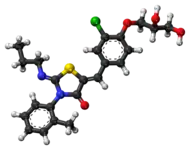Ponesimod
 | |
 | |
| Clinical data | |
|---|---|
| Trade names | Ponvory |
| Other names | ACT-128800 |
| AHFS/Drugs.com | Micromedex Detailed Consumer Information |
| License data | |
| Routes of administration | By mouth |
| ATC code | |
| Legal status | |
| Legal status | |
| Pharmacokinetic data | |
| Metabolism | 2 main metabolites |
| Elimination half-life | 31–34 hrs[3] |
| Excretion | Feces (57–80%, 26% unchanged), urine (10–18%)[4] |
| Identifiers | |
IUPAC name
| |
| CAS Number | |
| PubChem CID | |
| DrugBank | |
| ChemSpider | |
| UNII | |
| KEGG | |
| ChEMBL | |
| CompTox Dashboard (EPA) | |
| Chemical and physical data | |
| Formula | C23H25ClN2O4S |
| Molar mass | 460.97 g·mol−1 |
| 3D model (JSmol) | |
SMILES
| |
InChI
| |
Ponesimod, sold under the brand name Ponvory, is a medication for the treatment of multiple sclerosis (MS).[1][5]
The most common side effects include upper respiratory tract infection, hepatic transaminase elevation, and hypertension.[1][5]
Ponesimod was approved for medical use in the United States in March 2021[1][5] and in the European Union in June 2021.[6]
Clinical trials
In a 2009–2011 Phase II clinical trial including 464 MS patients, ponesimod treatment resulted in fewer new active brain lesions than placebo, measured during the course of 24 weeks.[7][8]
In a 2010–2012 Phase II clinical trial including 326 patients with psoriasis, 46 or 48% of patients (depending on dosage) had a reduction of at least 75% Psoriasis Area and Severity Index (PASI) score compared to placebo in 16 weeks.[7][9] The approval is already applied for in 2020.[10]
In a 2015–2019 Phase III randomised, double-blind clinical trial of 1133 adult patients with relapsing MS, those under ponesimod treatment showed a 30% reduction in annual relapse rate and a significantly reduced number of new inflammatory lesions on brain MRI by 56% compared to those taking teriflunomide.[11]
Adverse effects
Common adverse effects in studies were temporary bradycardia (slow heartbeat), usually at the beginning of the treatment, dyspnoea (breathing difficulties), and increased liver enzymes (without symptoms). No significant increase of infections was observed under ponesimod therapy.[7] QT prolongation is detectable but was considered to be too low to be of clinical importance in a study.[12]
Mechanism of action
Like fingolimod, which is already approved for the treatment of MS, ponesimod blocks the sphingosine-1-phosphate receptor. This mechanism prevents lymphocytes (a type of white blood cells) from leaving lymph nodes.[7] Ponesimod is selective for subtype 1 of this receptor, S1P1.[13]
Society and culture
Legal status
On 25 March 2021, the Committee for Medicinal Products for Human Use (CHMP) of the European Medicines Agency (EMA) adopted a positive opinion, recommending the granting of a marketing authorisation for the medicinal product Ponvory, intended for the treatment of active relapsing forms of multiple sclerosis.[14] The applicant for this medicinal product is Janssen-Cilag International N.V.[14] Ponesimod was approved for medical use in the European Union in May 2021.[2]
References
- 1 2 3 4 "Ponvory- ponesimod tablet, film coated Ponvory- ponesimod kit". DailyMed. Retrieved 31 March 2021.
- 1 2 "Ponvory EPAR". European Medicines Agency (EMA). 24 March 2021. Retrieved 18 December 2021.
- ↑ Brossard P, Scherz M, Halabi A, Maatouk H, Krause A, Dingemanse J (February 2014). "Multiple-dose tolerability, pharmacokinetics, and pharmacodynamics of ponesimod, an S1P1 receptor modulator: favorable impact of dose up-titration". Journal of Clinical Pharmacology. 54 (2): 179–88. doi:10.1002/jcph.244. PMID 24408162. S2CID 38041837.
- ↑ Reyes M, Hoch M, Brossard P, Wagner-Redeker W, Miraval T, Dingemanse J (February 2015). "Mass balance, pharmacokinetics and metabolism of the selective S1P1 receptor modulator ponesimod in humans". Xenobiotica; the Fate of Foreign Compounds in Biological Systems. 45 (2): 139–49. doi:10.3109/00498254.2014.955832. PMID 25188442. S2CID 23905158.
- 1 2 3 "Janssen Announces U.S. FDA Approval of Ponvory (ponesimod), an Oral Treatment for Adults with Relapsing Multiple Sclerosis Proven Superior to Aubagio (teriflunomide) in Reducing Annual Relapses and Brain Lesions" (Press release). Janssen. 19 March 2021. Retrieved 19 March 2021 – via PR Newswire.
- ↑ "European Medicines Agency Approval of Ponesimod".
{{cite web}}: CS1 maint: url-status (link) - 1 2 3 4 Spreitzer H (29 September 2014). "Neue Wirkstoffe – Ponesimod". Österreichische Apothekerzeitung (in German) (20/2014): 42.
- ↑ Olsson T, Boster A, Fernández Ó, Freedman MS, Pozzilli C, Bach D, et al. (November 2014). "Oral ponesimod in relapsing-remitting multiple sclerosis: a randomised phase II trial". Journal of Neurology, Neurosurgery, and Psychiatry. 85 (11): 1198–208. doi:10.1136/jnnp-2013-307282. PMC 4215282. PMID 24659797.
- ↑ Vaclavkova A, Chimenti S, Arenberger P, Holló P, Sator PG, Burcklen M, et al. (December 2014). "Oral ponesimod in patients with chronic plaque psoriasis: a randomised, double-blind, placebo-controlled phase 2 trial". Lancet. 384 (9959): 2036–45. doi:10.1016/S0140-6736(14)60803-5. PMID 25127208. S2CID 20452934.
- ↑ "Ozanimod bei schubförmiger MS zugelassen". Multiple Sklerose News – AMSEL (in German). 2020-07-06. Retrieved 2020-10-03.
- ↑ "Europe Approves Ponvory Ponesimod for Multiple Sclerosis".
{{cite web}}: CS1 maint: url-status (link) - ↑ Hoch M, Darpo B, Brossard P, Zhou M, Stoltz R, Dingemanse J (May 2015). "Effect of ponesimod, a selective S1P1 receptor modulator, on the QT interval in healthy individuals". Basic & Clinical Pharmacology & Toxicology. 116 (5): 429–37. doi:10.1111/bcpt.12336. PMID 25287214.
- ↑ "Ponesimod". Actelion. Archived from the original on 3 December 2011. Retrieved 31 October 2014.
- 1 2 "Ponvory: Pending EC decision". European Medicines Agency (EMA). 25 March 2021. Retrieved 27 March 2021.
External links
- "Ponesimod". Drug Information Portal. U.S. National Library of Medicine.